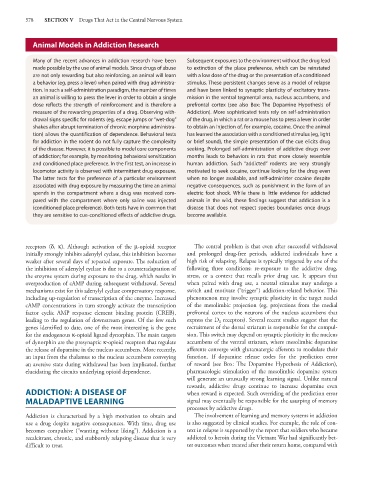Page 592 - Basic _ Clinical Pharmacology ( PDFDrive )
P. 592
578 SECTION V Drugs That Act in the Central Nervous System
Animal Models in Addiction Research
Many of the recent advances in addiction research have been Subsequent exposures to the environment without the drug lead
made possible by the use of animal models. Since drugs of abuse to extinction of the place preference, which can be reinstated
are not only rewarding but also reinforcing, an animal will learn with a low dose of the drug or the presentation of a conditioned
a behavior (eg, press a lever) when paired with drug administra- stimulus. These persistent changes serve as a model of relapse
tion. In such a self-administration paradigm, the number of times and have been linked to synaptic plasticity of excitatory trans-
an animal is willing to press the lever in order to obtain a single mission in the ventral tegmental area, nucleus accumbens, and
dose reflects the strength of reinforcement and is therefore a prefrontal cortex (see also Box: The Dopamine Hypothesis of
measure of the rewarding properties of a drug. Observing with- Addiction). More sophisticated tests rely on self-administration
drawal signs specific for rodents (eg, escape jumps or “wet-dog” of the drug, in which a rat or a mouse has to press a lever in order
shakes after abrupt termination of chronic morphine administra- to obtain an injection of, for example, cocaine. Once the animal
tion) allows the quantification of dependence. Behavioral tests has learned the association with a conditioned stimulus (eg, light
for addiction in the rodent do not fully capture the complexity or brief sound), the simple presentation of the cue elicits drug
of the disease. However, it is possible to model core components seeking. Prolonged self-administration of addictive drugs over
of addiction; for example, by monitoring behavioral sensitization months leads to behaviors in rats that more closely resemble
and conditioned place preference. In the first test, an increase in human addiction. Such “addicted” rodents are very strongly
locomotor activity is observed with intermittent drug exposure. motivated to seek cocaine, continue looking for the drug even
The latter tests for the preference of a particular environment when no longer available, and self-administer cocaine despite
associated with drug exposure by measuring the time an animal negative consequences, such as punishment in the form of an
spends in the compartment where a drug was received com- electric foot shock. While there is little evidence for addicted
pared with the compartment where only saline was injected animals in the wild, these findings suggest that addiction is a
(conditioned place preference). Both tests have in common that disease that does not respect species boundaries once drugs
they are sensitive to cue-conditioned effects of addictive drugs. become available.
receptors (δ, κ). Although activation of the μ-opioid receptor The central problem is that even after successful withdrawal
initially strongly inhibits adenylyl cyclase, this inhibition becomes and prolonged drug-free periods, addicted individuals have a
weaker after several days of repeated exposure. The reduction of high risk of relapsing. Relapse is typically triggered by one of the
the inhibition of adenylyl cyclase is due to a counteradaptation of following three conditions: re-exposure to the addictive drug,
the enzyme system during exposure to the drug, which results in stress, or a context that recalls prior drug use. It appears that
overproduction of cAMP during subsequent withdrawal. Several when paired with drug use, a neutral stimulus may undergo a
mechanisms exist for this adenylyl cyclase compensatory response, switch and motivate (“trigger”) addiction-related behavior. This
including up-regulation of transcription of the enzyme. Increased phenomenon may involve synaptic plasticity in the target nuclei
cAMP concentrations in turn strongly activate the transcription of the mesolimbic projection (eg, projections from the medial
factor cyclic AMP response element binding protein (CREB), prefrontal cortex to the neurons of the nucleus accumbens that
leading to the regulation of downstream genes. Of the few such express the D 1 receptors). Several recent studies suggest that the
genes identified to date, one of the most interesting is the gene recruitment of the dorsal striatum is responsible for the compul-
for the endogenous κ-opioid ligand dynorphin. The main targets sion. This switch may depend on synaptic plasticity in the nucleus
of dynorphin are the presynaptic κ-opioid receptors that regulate accumbens of the ventral striatum, where mesolimbic dopamine
the release of dopamine in the nucleus accumbens. More recently, afferents converge with glutamatergic afferents to modulate their
an input from the thalamus to the nucleus accumbens conveying function. If dopamine release codes for the prediction error
an aversive state during withdrawal has been implicated, further of reward (see Box: The Dopamine Hypothesis of Addiction),
elucidating the circuits underlying opioid dependence. pharmacologic stimulation of the mesolimbic dopamine system
will generate an unusually strong learning signal. Unlike natural
rewards, addictive drugs continue to increase dopamine even
ADDICTION: A DISEASE OF when reward is expected. Such overriding of the prediction error
MALADAPTIVE LEARNING signal may eventually be responsible for the usurping of memory
processes by addictive drugs.
Addiction is characterized by a high motivation to obtain and The involvement of learning and memory systems in addiction
use a drug despite negative consequences. With time, drug use is also suggested by clinical studies. For example, the role of con-
becomes compulsive (“wanting without liking”). Addiction is a text in relapse is supported by the report that soldiers who became
recalcitrant, chronic, and stubbornly relapsing disease that is very addicted to heroin during the Vietnam War had significantly bet-
difficult to treat. ter outcomes when treated after their return home, compared with

